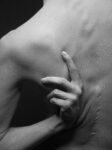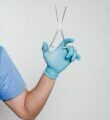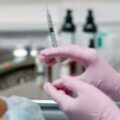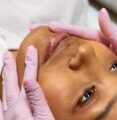If you’ve never heard of it before and thought it was a disease of the dirty and the homeless, you should pay attention. Scabies (Scabies hominis) is an infection of the skin caused by scabies, which is something I treat quite often in the clinic. Once every 10-15 years it hits our country in a mild epidemic. In this article you will learn a lot of useful and valuable information from my practice. Keep reading!
How does it manifest?
I often hear patients say, “This isn’t scabies, because it itches during the day, I don’t have any cornices on my skin, and I don’t have the typical twin pimples”. My practice in the Northwest and in Prague has taught me that scabies can look really different and we often have to think about it in the differential diagnosis of pruritus and exanthema.
The main symptom is itching of skin where it is most sensitive (hips, inner arms, forearms, skin between fingers, thighs, genitals). The itching is worst in the evening/night/early morning. However, I have also had patients who felt it to varying degrees throughout the day, some only a little, some not at all.
On the skin, it can manifest in a variety of ways. It can range from “nothing” to “rash from head to toe” and many in between. Sometimes it can make atopic eczema much worse and we wonder why the treatment doesn’t work.
Scabies can mimic a variety of rashes and eczema. Tiny pimples on sensitive areas of the skin are typical. The tunnels in the upper layers of the skin where the female germ lays her eggs are rarely seen, often only with a magnifying glass or dermatoscope. These pimples are a manifestation of our body’s allergic reaction to the parasite, it does not mean that there is a nematode in the pimple. There are no more than 10 of these parasites on the entire body at any given time. Some men may react to the pimple with hard nodules in the genital area. Very old, immunocompromised, or homeless individuals may have severe scabies (scabies norvegica), in which there are thousands of scabies on the body, forming heavily scabbed deposits (especially over the joints).
Where can you get infected?
You can catch it almost anywhere. It’s better not to think about it. The most common way is through direct contact with an infected person (sexual contact, living in the same household). Transmission from shared furniture in hotels and public transportation is no exception – just anywhere there are seats with fabric covers. I’ve had several patients who caught it while trying on clothes in a store.
How is scabies diagnosed?
There is NO test that will 100% confirm that you have scabies. There is no blood test that will show you have scabies (sometimes eosinophils or IgE are elevated, but many allergy sufferers have this). Histology is almost always non-specific – eczema (spongiotic dermatitis) or insect bites. Only once have I been able to take a skin sample directly – in a patient with scabies norvegica. The experience of the dermatologist is therefore essential for diagnosis. It is good not to underestimate scabies, but not to overestimate it either. I am very open with patients about the possibility of scabies infection.

How we treat scabies?
Sulphur ointment (in hospital beds) or Infectoscab (outpatient) are used in our countries. The sulphur ointment is applied to the whole body 2 times a day for a period of 3 days. During this time, do not take a shower. A cleansing bath is taken only on the 4th day. Apply a soothing cream to the body after the bath. In the case of Infectoscab, you massage the whole tube thoroughly into the skin of your whole body (from the chin to the fingertips), leave it on all night (8-10h), take a shower in the morning and use moisturizer. This step is important because both sulfur and Infectoscab dry the skin. I ALWAYS repeat this Infectoscab treatment after a week. For asymptomatic people and people who have no symptoms and have only been in contact with an infected person, one treatment is enough. It is important to apply Infectoscab or sulfur to the WHOLE body except the face, not just the pimples. Otherwise the treatment will have no effect!
Do not expect an instant miracle after treatment, the skin needs to calm down and it will take a while. Daily application of cream moisturizer will do the trick. It is possible that you will be given a weak cream with corticosteroids and some antihistamines. This will speed up the disappearance of the itching.
What kind of hygiene measures do you need to take in your home?
Scabies is destroyed by three things – HIGH TEMPERATURE (60 degrees or more), DISINFECTION AND TIME (starves to death).
After the first (and second) treatment with Infectoscab in the morning, wash your pajamas and completely change and wash your bedding. Clothes you have not worn recently (at least 2 weeks) are safe. Wash the rest of your clothes, and if they can be ironed, iron them and don’t wear them for 3 days. Set them aside and don’t wear them for 5 days if they cannot be ironed.
Wrap clothes and shoes that cannot be washed in plastic bags. Do not wear them for a week. If you have cloth furniture, cover it with a blanket for about a week. Then wash the blanket and put it away for a week. Disinfect what you can. You can add Sanytol powder to the wash.
How do I avoid infection?
Start with basic hygiene. Have your own towel and wash your sheets regularly, even if you are a family. Always wash store-bought and online clothes before first use. On public transportation (and in public facilities), sit so that you don’t touch exposed parts of your body. (Watch your hair and neck.) When you get home, change into your home clothes. If you are traveling, going to town, or working, do not sit on your couch or bed at home in the clothes you are wearing.
My advice outside the clinic
If you suspect scabies, be considerate of others and do not travel or share items with other family members. As a precaution, all household members and sexual partners should be treated (at the same time) if one family member is infected. If you share work or rest areas, your co-workers are also at risk. Once you have scabies, you do not develop antibodies. You can become infected again at any time. Manifestations are always on several or larger parts of the body, never in isolation (palms, feet, etc.).





